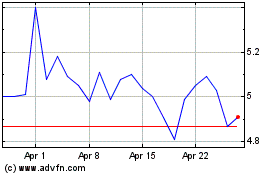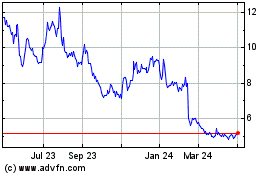Aurinia Pharmaceuticals Inc. (NASDAQ: AUPH) (Aurinia or the
Company) today announced that the United States Patent and
Trademark Office (USPTO) has allowed a method of use patent
application titled IMPROVED PROTOCOL FOR TREATMENT OF LUPUS
NEPHRITIS. Aurinia’s newly allowed U.S. Patent Application (No.
17/713,140) reflects the unique and proprietary dosing regimen of
its currently marketed product, LUPKYNIS. Specifically, this patent
further refines the method of using LUPKYNIS in combination with
mycophenolate mofetil (MMF) and corticosteroids using eGFR as a
method of pharmacodynamically dosing the product in patients with
lupus nephritis. The newly allowed application provides patent
coverage that supplements Aurinia’s existing U.S. Patent No.
10,286,036, which is listed in the Orange Book and claims an
FDA-approved method of using LUPKYNIS. The claims in this
additional patent add further specificity on dosing consistent with
the FDA approved product label. This patent has the potential to
provide an additional layer of patent protection for LUPKYNIS up to
2037. The Company intends to list this newly allowed patent in the
Orange Book once issued.
In addition, Aurinia is also announcing that it has recently
received a Notice of Intention to Grant from the European Patent
Office (EPO) for a patent application that has similar claims to
Aurinia’s existing method of use U.S. Patent No. 10,286,036. This
European patent application was pursued through the Patent
Cooperation Treaty (PCT) process. Once issued, this patent could
provide protection up to 2037 across Europe.
“This allowance by the USPTO and the concomitant news from the
European Patent Office further strengthens our Intellectual
Property portfolio as it pertains to LUPKYNIS and its unique
pharmacodynamic dosing protocol which is detailed in the FDA
package insert. These new patents, once issued, will enhance the
long-term potential of LUPKYNIS,” said Peter Greenleaf, Chief
Executive Officer of Aurinia.
About Lupus Nephritis
LN is a serious manifestation of SLE, a chronic and complex
autoimmune disease. About 200,000-300,000 people live with SLE in
the U.S. and about one-third of these people are diagnosed with
lupus nephritis at the time of their SLE diagnosis. About 50
percent of all people with SLE may develop lupus nephritis. If
poorly controlled, LN can lead to permanent and irreversible tissue
damage within the kidney. Black and Asian individuals with SLE are
four times more likely to develop LN and individuals of Hispanic
ancestry are approximately twice as likely to develop the disease
when compared with Caucasian individuals. Black and Hispanic
individuals with SLE also tend to develop LN earlier and have
poorer outcomes when compared to Caucasian individuals.
About LUPKYNIS
LUPKYNIS® is the first U.S. FDA- and EC-approved oral
medicine for the treatment of adult patients with active LN.
LUPKYNIS is a novel, structurally modified calcineurin inhibitor
(CNI) with a dual mechanism of action, acting as an
immunosuppressant through inhibition of T-cell activation and
cytokine production and promoting podocyte stability in the kidney.
The recommended starting dose of LUPKYNIS is three capsules twice
daily with no requirement for serum drug monitoring. Dose
modifications can be made based on Aurinia’s proprietary
personalized eGFR-based dosing protocol. Boxed Warning, warnings,
and precautions for LUPKYNIS are consistent with those of other
CNI-immunosuppressive treatments.
About Aurinia
Aurinia Pharmaceuticals is a fully integrated biopharmaceutical
company focused on delivering therapies to treat targeted patient
populations that are impacted by serious diseases with a high unmet
medical need. In January 2021, the Company introduced LUPKYNIS®
(voclosporin), the first FDA-approved oral therapy for the
treatment of adult patients with active lupus nephritis (LN). The
Company’s head office is in Victoria, British Columbia, its U.S.
commercial hub is in Rockville, Maryland, and the Company focuses
its development efforts globally.
Forward-Looking Statements
Certain statements made in this press release may constitute
forward-looking information within the meaning of applicable
Canadian securities law and forward-looking statements within the
meaning of applicable United States securities law. These
forward-looking statements or information include but are not
limited to statements or information with respect to: Aurinia
having patent protection to 2037; Aurinia’s intention to list the
newly allowed patent in the Orange Book once issued; and Aurinia’s
estimates as to the number of patients with SLE in the U.S. and the
proportion of those persons who have developed LN at time of SLE
diagnosis. It is possible that such results or conclusions may
change. Words such as “anticipate”, “will”, “believe”, “estimate”,
“expect”, “intend”, “target”, “plan”, “goals”, “objectives”, “may”
and other similar words and expressions, identify forward-looking
statements. We have made numerous assumptions about the
forward-looking statements and information contained herein,
including among other things, assumptions about: the accuracy of
reported data from third party studies and reports; and that
Aurinia’s intellectual property rights are valid and do not
infringe the intellectual property rights of third parties. Even
though the management of Aurinia believes that the assumptions
made, and the expectations represented by such statements or
information are reasonable, there can be no assurance that the
forward-looking information will prove to be accurate.
Forward-looking information by their nature are based on
assumptions and involve known and unknown risks, uncertainties and
other factors which may cause the actual results, performance, or
achievements of Aurinia to be materially different from any future
results, performance or achievements expressed or implied by such
forward-looking information. Should one or more of these risks and
uncertainties materialize, or should underlying assumptions prove
incorrect, actual results may vary materially from those described
in forward-looking statements or information. Such risks,
uncertainties and other factors include, among others, the
following: the market for the LN business may not be as estimated;
the results from Aurinia’s clinical studies and from third party
studies and reports may not be accurate; and Aurinia’s assets or
business activities may be subject to disputes that may result in
litigation or other legal claims. Although Aurinia has attempted to
identify factors that would cause actual actions, events, or
results to differ materially from those described in
forward-looking statements and information, there may be other
factors that cause actual results, performances, achievements, or
events to not be as anticipated, estimated or intended. Also, many
of the factors are beyond Aurinia’s control. There can be no
assurance that forward-looking statements or information will prove
to be accurate, as actual results and future events could differ
materially from those anticipated in such statements. Accordingly,
you should not place undue reliance on forward-looking statements
or information. All forward-looking information contained in this
press release is qualified by this cautionary statement. Additional
information related to Aurinia, including a detailed list of the
risks and uncertainties affecting Aurinia and its business, can be
found in Aurinia’s most recent Annual Report on Form 10-K and its
other public available filings available by accessing the Canadian
Securities Administrators’ System for Electronic Document Analysis
and Retrieval (SEDAR) website at www.sedar.com or the U.S.
Securities and Exchange Commission’s Electronic Document Gathering
and Retrieval System (EDGAR) website at www.sec.gov/edgar, and on
Aurinia’s website at www.auriniapharma.com.
INDICATION AND IMPORTANT SAFETY INFORMATION
INDICATIONS
LUPKYNIS is indicated in combination with a background
immunosuppressive therapy regimen for the treatment of adult
patients with active LN. Limitations of Use: Safety and efficacy of
LUPKYNIS have not been established in combination with
cyclophosphamide. Use of LUPKYNIS is not recommended in this
situation.
IMPORTANT SAFETY INFORMATION
BOXED WARNINGS: MALIGNANCIES AND SERIOUS INFECTIONS
Increased risk for developing malignancies and serious
infections with LUPKYNIS or other immunosuppressants that may lead
to hospitalization or death.
CONTRAINDICATIONS
LUPKYNIS is contraindicated in patients taking strong CYP3A4
inhibitors because of the increased risk of acute and/or chronic
nephrotoxicity, and in patients who have had a serious/severe
hypersensitivity reaction to LUPKYNIS or its excipients.
WARNINGS AND PRECAUTIONS
Lymphoma and Other Malignancies: Immunosuppressants, including
LUPKYNIS, increase the risk of developing lymphomas and other
malignancies, particularly of the skin. The risk appears to be
related to increasing doses and duration of immunosuppression
rather than to the use of any specific agent.
Serious Infections: Immunosuppressants, including LUPKYNIS,
increase the risk of developing bacterial, viral, fungal, and
protozoal infections (including opportunistic infections), which
may lead to serious, including fatal, outcomes.
Nephrotoxicity: LUPKYNIS, like other CNIs, may cause acute
and/or chronic nephrotoxicity. The risk is increased when CNIs are
concomitantly administered with drugs associated with
nephrotoxicity.
Hypertension: Hypertension is a common adverse reaction of
LUPKYNIS therapy and may require antihypertensive therapy.
Neurotoxicity: LUPKYNIS, like other CNIs, may cause a spectrum
of neurotoxicities: severe include posterior reversible
encephalopathy syndrome (PRES), delirium, seizure, and coma; others
include tremor, paresthesia, headache, and changes in mental status
and/or motor and sensory functions.
Hyperkalemia: Hyperkalemia, which may be serious and require
treatment, has been reported with CNIs, including LUPKYNIS.
Concomitant use of agents associated with hyperkalemia may increase
the risk for hyperkalemia.
QTc Prolongation: LUPKYNIS prolongs the QTc interval in a
dose-dependent manner when dosed higher than the recommended lupus
nephritis therapeutic dose. The use of LUPKYNIS in combination with
other drugs that are known to prolong QTc may result in clinically
significant QT prolongation.
Immunizations: Avoid the use of live attenuated vaccines during
treatment with LUPKYNIS. Inactivated vaccines noted to be safe for
administration may not be sufficiently immunogenic during treatment
with LUPKYNIS.
Pure Red Cell Aplasia: Cases of pure red cell aplasia (PRCA)
have been reported in patients treated with another CNI
immunosuppressant. If PRCA is diagnosed, consider discontinuation
of LUPKYNIS.
Drug-Drug Interactions: Avoid co-administration of LUPKYNIS and
strong CYP3A4 inhibitors or with strong or moderate CYP3A4
inducers. Reduce LUPKYNIS dosage when co-administered with moderate
CYP3A4 inhibitors. Reduce dosage of certain P-gp substrates with
narrow therapeutic windows when co-administered.
ADVERSE REACTIONS
The most common adverse reactions (>3%) were glomerular
filtration rate decreased, hypertension, diarrhea, headache,
anemia, cough, urinary tract infection, abdominal pain upper,
dyspepsia, alopecia, renal impairment, abdominal pain, mouth
ulceration, fatigue, tremor, acute kidney injury, and decreased
appetite.
SPECIFIC POPULATIONS
Pregnancy/Lactation: May cause fetal harm. Advise not to
breastfeed.
Renal Impairment: Not recommended in patients with baseline eGFR
≤45 mL/min/1.73 m2 unless benefit exceeds risk. Severe renal
impairment: Reduce LUPKYNIS dose.
Mild and Moderate Hepatic Impairment: Reduce LUPKYNIS dose.
Severe hepatic impairment: Avoid LUPKYNIS use.
Please see Prescribing Information, including Boxed Warning, and
Medication Guide for LUPKYNIS.
View source
version on businesswire.com: https://www.businesswire.com/news/home/20230124006056/en/
Investor/Media: Aurinia@westwicke.com
Aurinia Pharmaceuticals (NASDAQ:AUPH)
Historical Stock Chart
From Mar 2024 to Apr 2024

Aurinia Pharmaceuticals (NASDAQ:AUPH)
Historical Stock Chart
From Apr 2023 to Apr 2024
